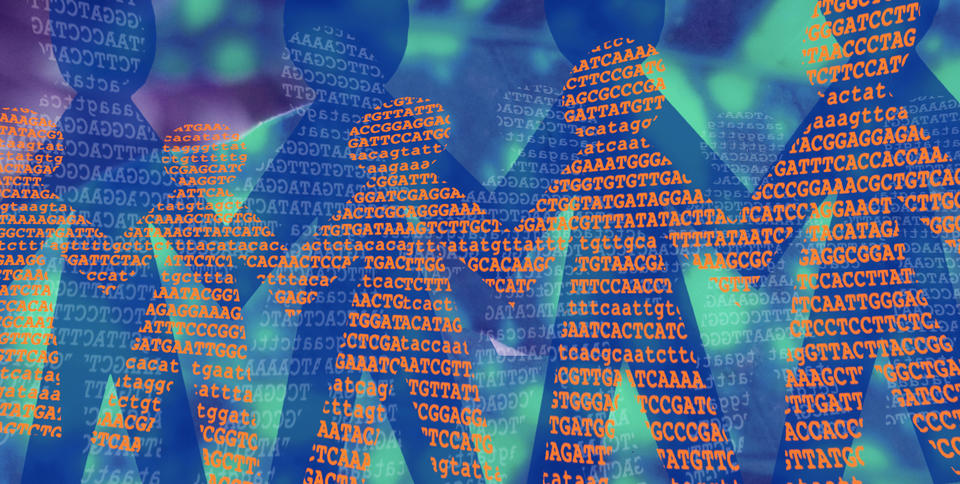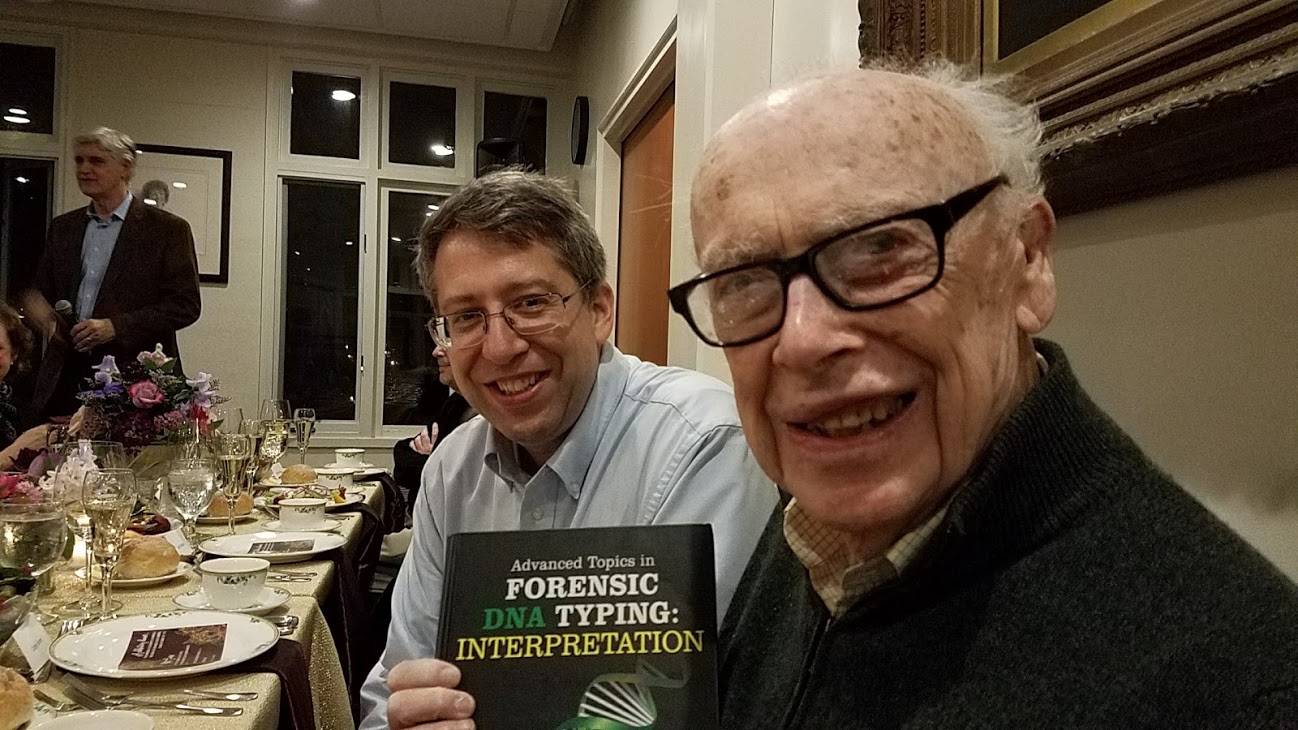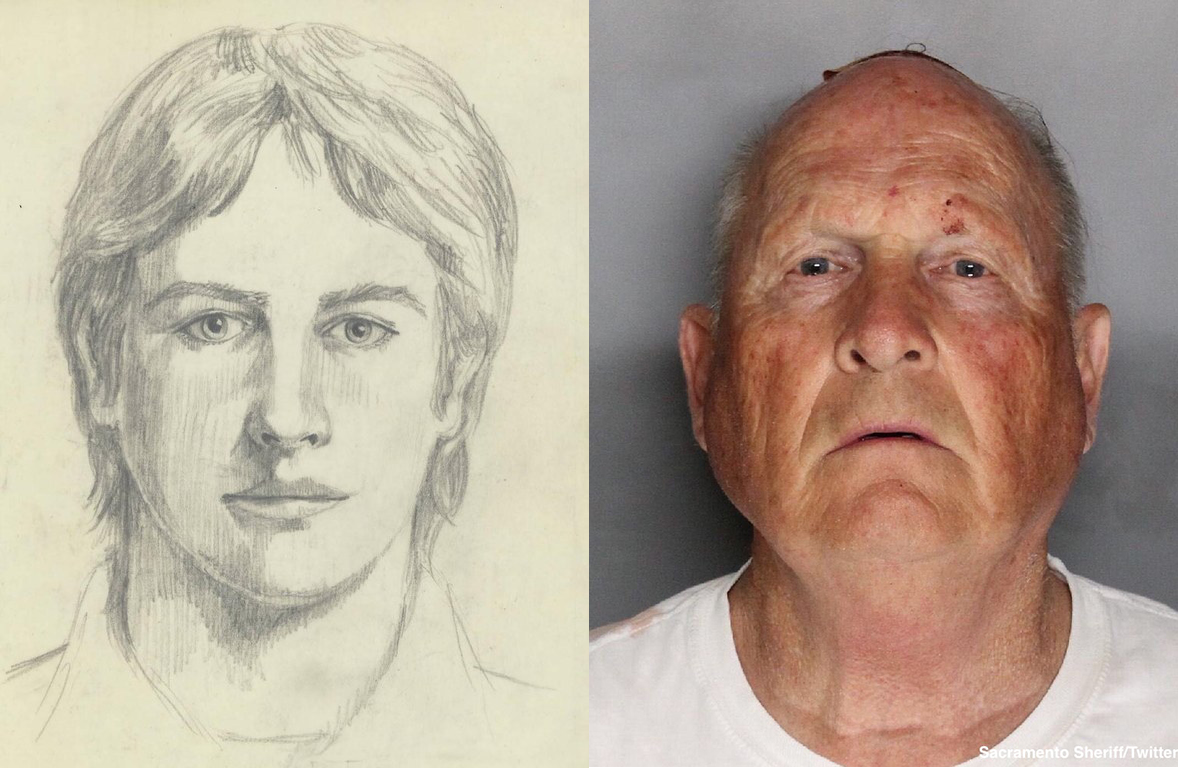Taking Measure
Just a Standard Blog

The rise of genetic genealogy services has helped police crack numerous cold cases by tracing perpetrators through their family members. The letters A, G, T, and C represent the building blocks of DNA.
Happy National DNA Day! Each year on April 25 we celebrate the 1953 publication of James Watson, Francis Crick, Maurice Wilkins, and Rosalind Franklin’s discovery of DNA’s double helix. The day also marks the completion of the first human genome sequence in 2003.
In February 2018, I gave an invited lecture at the Cold Spring Harbor Laboratory in New York on forensic DNA and the role of the National Institute of Standards and Technology in strengthening forensic science at a special event honoring Watson and Crick’s discovery. At the event, I had the honor of meeting Watson himself. I enjoyed sharing a copy of my latest book on forensic DNA typing with this great scientist as we reviewed the application of DNA to solve crimes and its impact over the years.
DNA Databases
One of the advances Watson and I discussed was the value of using DNA databases to assist criminal investigations. But traditional DNA databases, such as the National DNA Index System (NDIS) run by the FBI, only work if the suspect’s DNA is already on file as a result of the person being caught or convicted for a previous crime. Law enforcement DNA databases are usually very effective because criminals typically start with small violations that get them entered into the database before they progress to more serious crimes that they can be connected to using information from their initial entry. NDIS contains more than 17 million offender and arrestee profiles that are regularly compared with almost 1 million crime scene profiles. Over the past 20 years, NDIS has assisted about 450,000 law enforcement investigations. However, many cases go unsolved because the perpetrator operates under the radar. That all changed a year ago …

Apprehension of the Golden State Killer
On National DNA Day last year, criminal investigations involving DNA evidence took a dramatic step forward when the Sacramento, California, district attorney announced the arrest of 72-year old Joseph DeAngelo. This arrest had come using a game-changing nontraditional approach.
For more than 40 years, police had been searching for an individual variously referred to as the “Original Night Stalker,” the “Visalia Ransacker” or the “East Area Rapist.” From the 1970s to the mid-1980s, this individual terrorized Sacramento and Southern California, murdering 13 people, raping at least 50 women, and burglarizing more than 120 homes. DNA evidence connected several of the crime scenes, but the perpetrator, eventually dubbed the “Golden State Killer,” eluded entry into any law enforcement DNA database.
Six weeks before the arrest of Joseph DeAngelo, I spoke in Anaheim to about 100 prosecutors from the California District Attorneys Association (CDAA) regarding the science of forensic DNA testing and its limitations. At this meeting, one of the prosecutors who had worked this case for many years spoke about getting arrestees and convicts enrolled in California’s and neighboring states’ DNA databases.
Gathering DNA from arrestees and the practice of searching databases for DNA profiles that were similar to that of the suspect's had been started a decade earlier in California in an effort to find the elusive Golden State Killer, but even with these additional efforts, the trail to this killer was still cold. The prosecutor said it was possible that the Golden State Killer had already died or was sitting in a Nevada prison but had not yet been entered into that state's DNA database. Little did we know that even as the CDAA met, the net was closing in on the Golden State Killer as a new use for DNA was emerging from a different group—genealogy enthusiasts.
Genetic Genealogy
A few years ago, I was invited to speak at a family history conference in Charlottesville, Virginia, regarding DNA testing and its potential use in genealogical research. As part of my talk, I decided to take two DNA ancestry tests so that I could share my experience and results. After spending $89, spitting in a tube to supply some DNA, signing disclosure forms and then waiting two weeks, I found out that I have mostly European ancestry. No surprises there! The other company I used took a little longer but produced similar results.
Full disclosure—I have a sister who is a professional genealogist, and my family history over the past several hundred years is well documented in large measure because many of my ancestors have been in the United States since the early 18th century—so, in my case, DNA testing didn’t reveal all that much. However, what I was not expecting was that enrolling my DNA sample in a genetic genealogy database would result in almost overnight connections to cousins whom I would not have located otherwise. Since my results were entered in the two company databases almost three years ago, I have received numerous “matches” to second, third or even potential fourth cousins. I now regularly get emails from these distant relatives or invitations via the genetic genealogy companies to reach out to them to explore our shared genetic heritage.
Since that initial talk in Charlottesville, I have been invited about half a dozen times to speak to members of the general public and genealogy enthusiasts in Virginia and Maryland. People seem eager to learn more about their heritage through DNA testing, and typically I find that about a third to a half of the audiences I address have had their DNA tested. According to a news article earlier this year, more than 26 million people have taken a DNA ancestry test.
Last week I spoke to about 40 people at the Rockville Science Café —and about a third of those in attendance had had their DNA tested. The audience asked some excellent questions, and we discussed the capabilities and limitations of genetic genealogy—and the Golden State Killer investigation and its impact on criminal DNA investigations.
Genetic Genealogy Aids Criminal Investigations
The development of a publicly accessible database known as GEDmatch for DNA data in 2010 and the rapid growth in the number of DNA ancestry tests being uploaded are what have enabled genetic genealogy to assist criminal investigations, including the breakthrough in the Golden State Killer case. Several different things had to come together to make this possible.

First, the police needed to have a single-source crime scene sample of sufficient quality and quantity to obtain a profile with all the DNA markers used in genetic genealogy. Having this data enables the perpetrator’s profile to be compared with other people in a genetic genealogy database. If we think of a criminal investigation as a fishing expedition, then we need “bait” to go fishing. In the Golden State Killer case, it was an old semen stain from a sexual assault kit.
Second, the police needed a large number of genetic genealogy tests, i.e., the more fish in the sea, the better chance you’ll catch the right fish.
Third, the police needed a high density of DNA markers to provide a tighter fishing net. Biogeographical ancestry and information, such as eye color, can be helpful here. These types of markers are not typically used in traditional forensic testing.
Fourth, the police needed a community resource to share information. In this case, it was GEDmatch where law enforcement discreetly introduced the crime-scene sample as an individual. This is essentially the fishing hole.
Fifth, the police had to do a lot of dedicated detective work to create family trees and track down potential leads. In our analogy, this equates to having the time to fish along with a quiet means releasing the wrong fish when hooked.
Finally, the police needed a secret collection of confirmation samples from discarded DNA to demonstrate that the investigation had hooked the right fish. Regular DNA testing with traditional forensic markers is used to confirm a match of the individual under suspicion to the original crime scene results.
All of these things were done in the Golden State Killer investigation during the early months of 2018, which led to the announcement of Joseph DeAngelo’s arrest last April. Since that time, several dozen other cold cases have been solved in a similar manner—with genetic genealogy and many, many hours of careful investigative work to follow the genetic leads.
I enjoy working at NIST where we can do world-class research, collaborate to solve important problems and share what we learn with others. Writing five forensic DNA textbooks over the past two decades has given me a unique vantage point to see the field, where we have come from and where we are headed. For example, in one of my books, I write: “The future may involve more interaction between the application of genetic genealogy and forensic science to help bring cases to closure without prior suspects.”
Although I personally had nothing to do with the genetic genealogy investigation that led to the arrest of Joseph DeAngelo, the words I had written years earlier proved to be prophetic. Within a few days of DeAngelo’s arrest, news stories around the world discussed the revolutionary method used—as well as the privacy implications raised from this type of searching.
With the research we do at NIST, we often do not know the impact that we can have on the future. I am now working in the Special Programs Office on a congressionally funded effort to examine the scientific foundations of forensic science disciplines. Our first study is on DNA mixture interpretation, which was explained in a NIST feature story. Perhaps a future blog post will cover this topic and the impact of our work here at NIST.
Only time will tell.
About the author
Related Posts
Comments
Hi Jane, I am glad that you enjoyed the article. I am sure that your family research has been a big help to AFDIL and the DOD in their work to identify remains of servicemen from the Korean War and other conflicts. I would encourage you to stay involved where you can. The work of genealogists is crucial in these investigations. Best wishes, John






Very much enjoyed this article, and I'm also an avid genetic genealogist. I've helped several friends learn the identities of unknown parents, grandparents, great grandparents, etc... , and it's so gratifying. The best ever was uniting a woman given up for adoption with her biological father and paternal grandparents on Father's Day of all days. It's going to be tough to beat that.
Another activity I was so happy to be involved with was helping with the effort to find living, relevant mtDNA donors to aid in the identification of remains of servicemen lost in the Korean War.
So much can be done to help humanity with this science, and I'm honored to be a part of it.